Shiraz Tourist Attractions
The Tomb of Sheikh Rouzbahan Baqli: Shiraz’s Sufi Pilgrimage
The Tomb of Sheikh Rouzbahan Baqli, with its intricate tilework and spiritual ambiance, honors the legacy of the renowned Persian mystic and poet in Shiraz.
Read moreEstakhr Ancient City: Capital of the Sassanian Empire
Estakhr ancient city also known as Takht-e-Tavoos was once one of the most prosperous cities of ancient Persia and was the capital of the Sassanian Empire.
Read more5 Best Historical Houses in Shiraz | Iran’s Architectural Marvels
Shiraz's historical houses, with their intricate tilework and grand courtyards, offer a glimpse into the city’s rich architectural heritage.
Read moreBovan Gorge (Tang-e Bovan) | Shiraz’s Stunning Natural Landscape
Bovan Gorge, known locally as Tang-e Bovan, is a captivating natural site nestled in the Fars Province near Shiraz, Iran.
Read moreUltimate Guide to Afif Abad Garden and Museum in Shiraz
Afif Abad Garden and Museum, with its beautiful landscapes, offers a serene setting for exploring a fascinating collection of military artifacts.
Read moreA Guide to Bibi Dokhtaran Mausoleum in Shiraz
The Bibi Dokhtaran Mausoleum in Shiraz is one of the city’s revered sites, built in honor of Bibi Khadijeh, a descendant of Imam Sajjad and also known as Umm Abdullah.
Read moreJahan Nama Garden: History, Design & Practical Visitor Tips
Jahan Nama Garden, one of the oldest gardens in Shiraz city, holds a distinct place due to its ancient origins and connection to Shiraz's illustrious past.
Read moreSaraye Moshir - Shiraz’s Traditional Marketplace
Saraye Moshir, also known as Moshir Arcade, is a traditional Bazaar in Shiraz built during the Qajar era in the 19th century and located near the famous Vakil Bazaar.
Read moreMeshkinfam Historical House and Museum in Shiraz
The Meshkinfam Historical House, also known as Forough Al-Mulk's house, is a captivating gem in the heart of Shiraz. This historic mansion, dating back to the late Qajar and early Pahlavi eras, is a must-see for anyone passionate about art and history.
Read moreTang-e Bostanak: The Lost Heaven of Shiraz
Tang-e Bostanak, also known as Beheshte Gomshodeh meaning the lost paradise, is one of the most breathtaking natural treasures in Iran. Nestled in the heart of the Zagros Mountains, this protected area in Marvdasht County, 120 km northwest of Shiraz, offers an escape into pristine nature.
Read moreZinat Al-Molk Historical House in Shiraz, Iran
Zinat Al-Molk Historical House is one of the most significant cultural landmarks in Shiraz, Iran.
Read moreManteghi Nezhad Historical Mansion in Shiraz, Iran
The Manteghi Nezhad Historical Mansion is one of the most notable architectural landmarks in Shiraz, offering a rich representation of Persian domestic architecture.
Read moreHaft Tanan Museum in Shiraz - Stone Art, History, and Architecture
Haft Tanan Museum in Shiraz is a fascinating spot that combines history, art, and nature all in one place.
Read moreTomb of Baba Koohi: Shiraz’s Spiritual and Historical Site
The Tomb of Baba Koohi in Shiraz is one of the most beloved attractions and leisure spots in the city, situated on the outskirts of the city. It is a historical monument dating back to the Qajar era located on Saboy Mountain near the Quran Gate.
Read moreSarvestan Sasanian Palace | Magnificant Ancient Persian Architecture
The Sarvestan Sasanian Palace is an impressive example of ancient Persian architecture, showcasing the skill and creativity of the Sasanian Empire.
Read morePars Museum in Shiraz | History, Art, and Visitor Tips
Shiraz, a city in southern Iran, is known for its rich history, stunning gardens, and deep connection to poetry and art. Often called the cultural capital of Iran, Shiraz attracts visitors with its ancient sites, vibrant bazaars, and warm hospitality.
Read moreDelgosha Garden | One of Shiraz's Must-See Attractions
Shiraz, a city known for its beautiful gardens, rich history, and vibrant culture, is one of the top destinations for visitors to Iran. Among its many attractions, Delgosha Garden stands out as a peaceful and picturesque spot that offers a unique experience.
Read moreShapouri House | A Must-Visit Landmark in Shiraz
Shiraz, renowned for its poetry and vibrant floral landscapes, has long captivated visitors with its stunning gardens and historical estates. The sight of towering trees intertwined with centuries-old mansions leaves a lasting impression on those who explore this city.
Read moreKhan School: Shiraz’s Ancient Learning Institution
The Khan School or Madrese Khan once hosted the renowned philosopher Mulla Sadra, and was built in the early 17th century by Allahverdi Khan and his son, Imam Qoli Khan, with the support of Shah Abbas during the Safavid era.
Read moreQuran Gate | The Marvelous Symbol of Shiraz, Iran
Quran Gate (Darvazeh Ghoran) stands as a prominent historical and cultural landmark in Shiraz, Iran. This monumental gate, deeply rooted in the city’s history, has long served as both a spiritual and physical gateway for those entering Shiraz.
Read moreNarenjestan-e Ghavam (Qavam House) | Shiraz Must-Visit Attractions
Iranian gardens are a defining element of the country's architectural landscape, with examples found across the nation. Narenjestan Garden, also commonly referred to as Qavam Garden, is among the most exquisite sites in Shiraz.
Read moreThe Arg of Karim Khan in Shiraz | History and Architecture
Shiraz, a city rich in historical monuments, attracts numerous tourists each year. Among its most significant historical landmarks is Arg of Karim Khan, also known as Karim Khani Citadel, commissioned by Karim Khan Zand, the founder of the Zand dynasty, who was honored with the title Vakil ol-Ra'aya.
Read moreNasir-ol Molk Mosque: The Pink Mosque of Shiraz
Renowned as the Pink Mosque or Rainbow Mosque, Nasir-ol Molk Mosque is one of the most ancient and stunning mosques in Shiraz, Iran, and offers a visual feast unlike any other.
Read moreMaharloo Lake: Red Waters, Green Initiatives
Situated near the historic city of Shiraz, Maharloo Lake is renowned for its striking pink hue, casting a spellbinding charm on all who behold it.
Read moreBest Hotels in Shiraz You Never Want to Leave
Shiraz is absolutely one of the most popular and visited cities in Iran due to a number of amazing and historical places in the city.
Read moreTop 15 Traditional Hotels in Shiraz to Stay in
Shiraz is one of the most visited cities in Iran by both local people and international visitors who travel to Shiraz in the hope of visiting some of the most magnificent sightseeing in and around the city. If you are planning to travel to Iran and Shiraz is in your itinerary, you may wonder about where to stay.
Read moreTomb of Hafez | Famous Persian Poet
There is no way a Persian will hear Shiraz's name and not immediately think about Hafiz.
Read moreBest Restaurants in Shiraz You Shouldn't Miss!
Steeped in history and culture, Shiraz is a vibrant city where succulent kebabs, aromatic saffron rice, and fragrant spices fill the air and beckon you to indulge in the ultimate Persian dining experience.
Read morePersian Griffin Meaning & Statue
A significant percentage of any country's arts and culture is influenced by the thoughts and attitudes of its citizens.
Read moreThe Most Beautiful Gardens in Shiraz
The city of Shiraz in one of the most amazing cities in Iran which has a number of beautiful gardens. If you travel to Shiraz in spring, you will be amazed by the magnificent fragrance of orange blossoms which spread all over the town. Here, we are going to introduce some of the most beautiful gardens in Shiraz.
Read more13 Best Places to Visit in Shiraz
Shiraz is one of the most historical cities in Iran which has wonderful gardens, amazing monuments, and breathtaking mosques.
Read moreShah Cheragh Mausoleum | The Magnificent Mirrored Mosque in Shiraz
There are a number of mosques, holy shrines, and Imam Zadeh in Iran, and Shah Cheragh Mausoleum is the third most important religious sites in the country. The mausoleum attracts millions of tourists on an annual basis.
Read moreHafezieh | Review of Tomb of Hafez in Shiraz
With a long history, and being the center of culture in Iran, Shiraz is well-known for being home to a number of sightseeing, including traditional houses, historical monuments, and tombs of greatest poets in Iran; Hafez and Sa’adi.
Read moreThe Magnificent Colorful House of Qavam in Shiraz
In addition, to be one of the most historical and popular cities in Iran, Shiraz is home to a number of beautiful historical housed date back to centuries ago. Among all of these houses, the magnificent colorful house of Qavam in Shiraz, which is also known as Narenjestan-e Qavam or Qavam Garden, is the most popular historical house in the city.
Read moreShiraz Travel Guide | Top Tourist Attractions
Shiraz is one of the most amazing and historical cities in Iran which is also well-known for its famous poets, Persian Gardens, traditional houses and of course the Persepolis. The city is almost included in all tourists’ itineraries, and people who travel to Iran for the first time, never go back to their homes, without visiting Shiraz, the city of art and poems.
Read moreEram Garden | Paradise on Earth
The moment you hear the name of city Shiraz, you can definitely smell the fragrance of citrus, with unparalleled effects in front of you. You can go for hours wandering on its streets and fulfilling your moments with a magnificent flavor, or give your heart to Hafiz and Saadi, and review their poems to learn life lessons.
Read moreVakil Complex; Combination of Citadel, Mosque, Bath, and Bazaar
With a great heritage, there are numbers of historical houses, gardens, and monuments in Shiraz, which makes the city one of the most visited one in Iran. Among all of these places, one of the most popular ones in the heart of the city is Vakil or Zandiyeh complex.
Read moreShiraz Tourist Attractions
The ancient city of Shiraz has been highly touted as the heartland of Persian culture for over 2000 years, and it has become synonymous with education, nightingales, poetry, flowers, and gardens.
Shiraz: The Ancient City of Love and Literature
Shiraz is a center for Iranian culture and the motherland of famous poets and mystics like Hafez and Saadi. Many scientists also originate from Shiraz, such as Qutb al-Din al-Shirazi, a 13th-century astronomer, mathematician, physician, physicist, and scientist. Shiraz is also home to splendid gardens, exquisite mosques, and whispered echoes of ancient sophistication. The city's agreeable climate, set in a fertile valley once famed for its vineyards, makes it a pleasant and salubrious place to visit except at the humid height of summer or the freezing depths of winter.
Many Iranians also consider Shiraz the city of gardens due to the presence of many gardens and fruit trees that can be seen throughout the city. Parks such as the Eram Garden and the Afif Abad Gardens are unique examples of its people's hospitality and warmness and bear many historical and ancient attractions. I cannot afford not to mention the old cities of the Persian Empires, such as Persepolis, Necropolis, and Pasargadae, which correspond to the nation's history and glory. You can feel the highlights of the cultural city of Shiraz if you travel to this lovely city during the spring when the fragrance of flowers and orange trees blossom to fill the air with a pleasant aroma.
Shiraz is the fifth-most-populous city in Iran, with a population of 1,995,500 people, and it is the capital of Fars Province, which has been historically known as Pars or Persis. The city is located in the south of Iran and the northwest of Kerman Province and has a seasonal or dry river (in Farsi: Rudkhaneye Khoshk) flowing through the northern part of the city and onto Maharloo Lake.
Shiraz has a moderate climate with distinct seasons and is overall classed as cold semi-arid weather, the summers are sweltering, arid, and clear, and the winters are cold and mostly clear. Shiraz was the capital of Iran during the Zand dynasty from 1750 until 1800. It is also one of the oldest cities in ancient Iran, the earliest reference to the city, known as Tiraziš, dated 2000 BCE, was located in the Elamite states that are now Khuzestan and Ilam Province.
Shiraz was known as the leading center of arts, poetry, education, and letter writing since the 13th century due to the encouragement of its ruler and the presence of many Persian scholars, poets, and artists. Shiraz is also internationally renowned for its inlaid mosaic work of triangular design, silverware, and weaving of flat tapestry-woven carpets (also called kilim in the villages).
Top 16 Shiraz Attractions
Shiraz is key to tourism in Iran, and although there are numerous places to visit in Shiraz, from the snake-like Margoon Waterfall to the Sassanid-era building of Sarvestan Palace. Still, you should pay a visit to its marvelously attractive gardens, which are numerous, extraordinarily beautiful, and eye-catching. You will have a fantastic experience after visiting the important religious sites of this city, which are painted colorfully to mesmerize the people who visit the places. The play of colors in the design of these sites is very relaxing, mind-blowing, and sacred.
This cultural and serene city will make you believe you're dreaming. But trust us, you aren't. We can help you discover hundreds of better places to visit and help you satisfy your curiosity by learning about our diverse regions and lively cities all in one place. Below are some of our favorite local haunts, tourist spots, and hidden gems throughout Shiraz.
1. Nasir al-Mulk Mosque
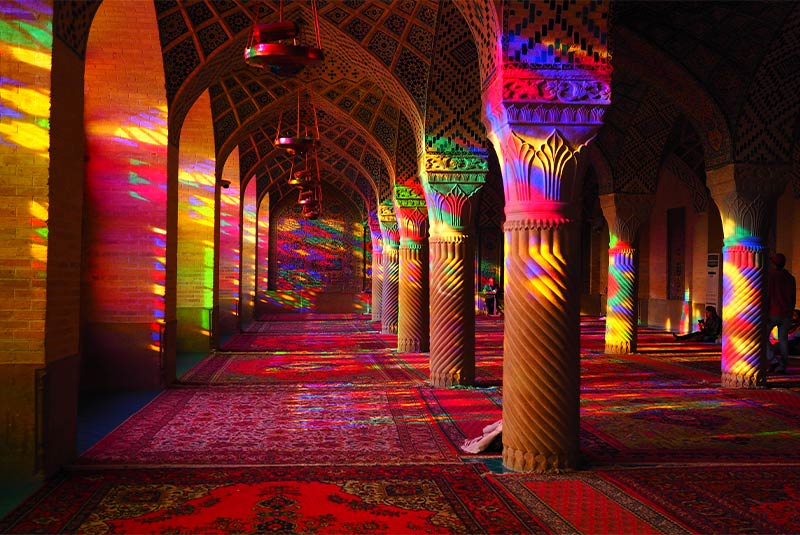
The Nasir Al Mulk Mosque, also reputed as the Pink Mosque, is the most colorful and wonderful mosque in Iran and is located in the beautiful city of Shiraz. Nasir al-Mulk Mosque was constructed between 1876 and 1888 by order of one of the Qajar Dynasty lords, who ruled Iran from 1785 to 1925. Muhammad designed the beautiful and historic mosque Hasan-e-Memar and Muhammad Reza Kashi Paz-e-Shirazi.
This gorgeously colorful place of worship is filled with dazzling stained glasses, painted tiles on the ceiling and Persian rugs covering the floor giving it a dreamlike quality, especially if you visit when the sun streams through in the morning. This place of worship has been dubbed the "Pink Mosque" due to the plethora of pink-colored tiles blanketing the ceiling, making it gorgeous and caressing the eyes.
In addition to the glorious display inside, the exterior is equally impressive, with an open courtyard with a long, rectangular, and reflecting pool. Those looking to take a peek themselves will want to visit this mosque in the morning, when the sun reflects the stained glass patterns onto the floor, transforming the halls into a dazzling wonderland of rich hues, practices, and light play on the base of the mosque.
2. Persepolis (Takht-e Jamshīd)
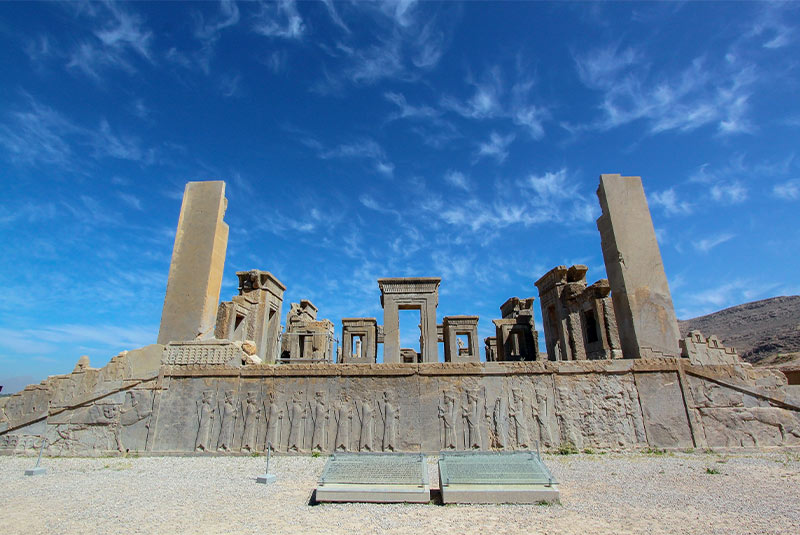
Persepolis is one of Shiraz's most iconic tourist attractions, and Darius 1 found it in 518 B.C. Persepolis was the capital of the Achaemenid Empire. It is situated in the plains of Marvdasht, encircled by the southern Zagros mountains of Iran. It includes 125,000 square meters (1,350,000 sq. ft.) terrace, where the king of kings created an impressive palace complex inspired by Mesopotamian models. The importance and quality of the monumental ruins make it a unique archaeological site.
Persepolis holds many items and symbols of Persian hospitality. You will see the enormous Gate of All Nations when you reach the top of the monument. One of the regular patterns that you will notice when you are visiting Persepolis is the lotus flower. Lotus is one of the Persian national icons. This symbol refers to the Goddess Anahita, the goddess of water and wisdom.
You can also find various carings on Persepolis walls, from Javid Army (the immortal army) to figures of people from various ethnic groups (white and black colors) on different social occasions such as dealing, tendering presents to the king, holding a lover's hands, and even animals from all the kingdom.
"In 1979 the remnants of Persepolis were registered as a UNESCO World Heritage site."
3. Pasargadae
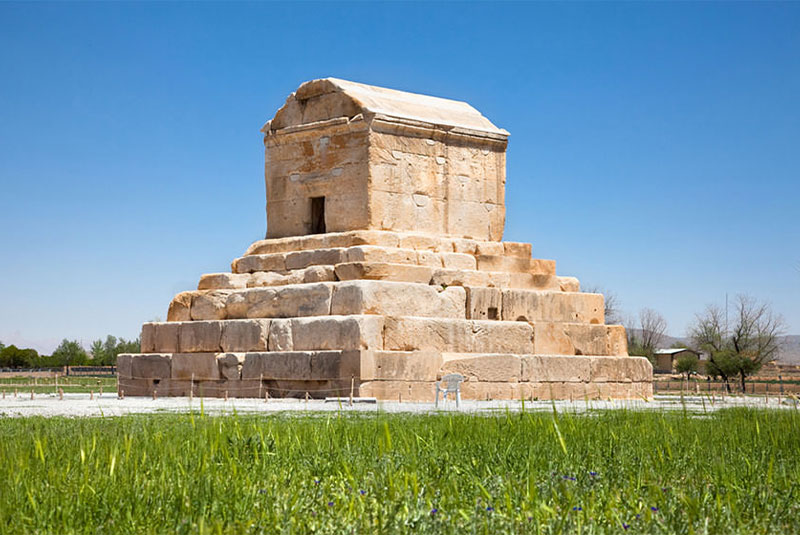
Pasargadae was the capital of the Achaemenid Empire under Cyrus the Great and remained the capital of the Achaemenid Empire until Cambyses II moved it to Susa. The archaeological site of Pasargadae covers 1.6 square kilometers. It houses the grave of Cyrus the Great, who confederated two powerful Aryan states, Media and Persia, and established the Persian Empire by 559 B.C. It also includes the fortress of Toll-e Takht sitting on top of a nearby hill and the remains of two royal palaces and gardens.
"In 2004 the remnants were registered as a UNESCO World Heritage site."
4. Naqshe Rostam
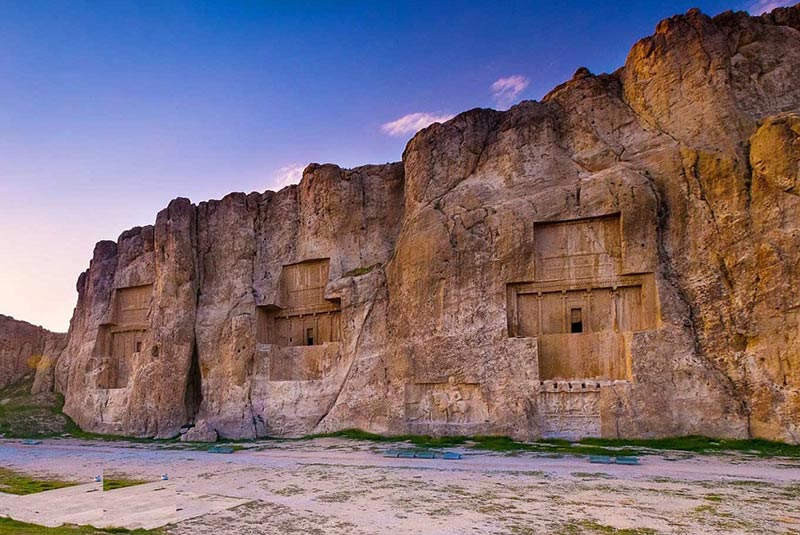
Naqsh-e Rustam is an ancient cemetery with monumental rock-cut tombs holding the remains of four Achaemenid kings. Only the great Persian king, Darius I, has been identified with certainty. However, Archaeologists believe the other three kings buried here are Xerxes I, Artaxerxes I, and Darius II. The ancient Naqshe Rustam is situated northwest of Persepolis and is an impressive reminder of the once glorious, famous.
The mighty Achaemenid Persian Empire, which thrived between 500 BC and 330 BC, was defeated by Alexander the Great. The nearby ancient capital of Persepolis has overshadowed Naqshe Rostam, but this royal necropolis does stand out as a magnificent manifestation of ancient Persian architecture and art. Aside from the tombs, a building also stands at the cemetery called Ka'ba-ye Zartosht (Cube of Zoroaster), whose actual use is unknown. Although there is currently no consensus on the specific use of this structure, it is widely accepted that it serves a religious function. However, it is thought to be the site of a perennially burning fire common in Zoroastrian temples, but the lack of ventilation suggests otherwise.
Zartosht Kaabe (Cube of Zoroaster)
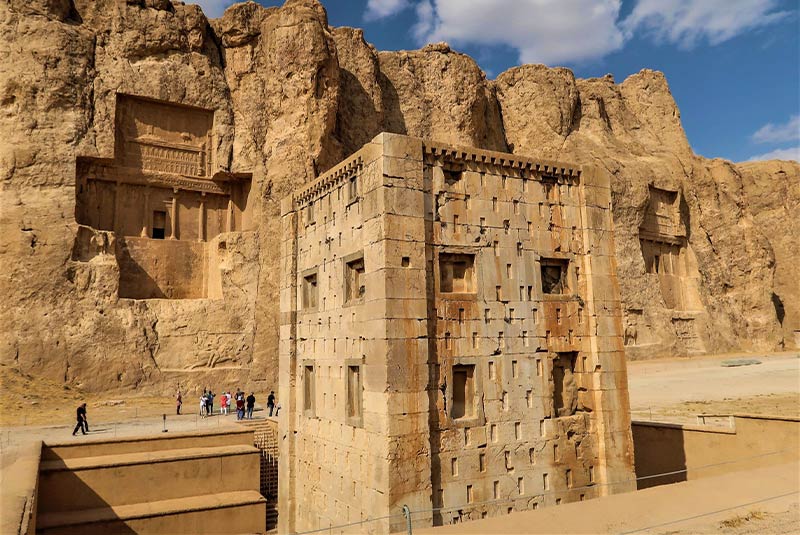
Ka'ba-ye Zartosht, or Cube of Zoroaster, is a cuboid-shaped stone inside Naqsh-e-Rostam. This stone is made out of white marble limestone. The use of this stone is still a mystery, and some say it could be a temple to Anahita (goddess of water), or tomb of a high-ranking Zoroastrian priest, or a place for keeping holy manuscripts. Some archaeologists also believed the structure to be a mausoleum, and some think it was a fire temple in which the sacred fire was placed and used during religious ceremonies. Many groups feel it was a treasury and a place to keep religious documents.
5. Naghsh-e Rajab
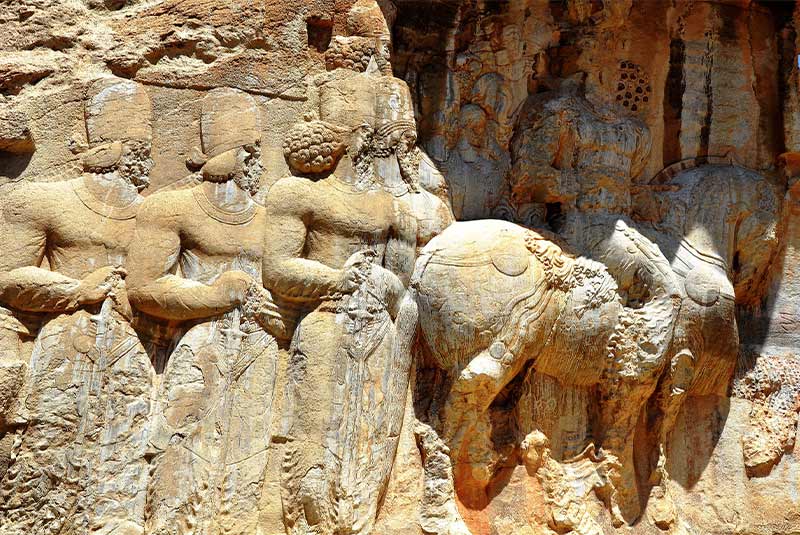
The Naghsh-e Rajab is a historical site in the north of the Persepolis that dates back to the rules of Ardeshir I and Shapur the Great, two of the Sassanid Emperors (224 – 642 A.C)Naqsh-e Rajab is the location devoted to four bas-reliefs dating back to the early Sassanid period. One of the reliefs is the crowning inscription of Ardeshir I (r. 226 – 241), the founder of the Sassanid Empire. The second crowning description is allocated to the Ardeshir’s inheritor, Shapur I (r. 241 – 272). the third relief, known as ‘Shapur’s Parade,’ honors the monarch’s conquest in 244 over the Roman ruler Valerian and Philip the Arab. The fourth relief and description is regarding the Kartir, priest Shapur I and his sons Hormizd I (r. 272 – 273) and Bahram I (r. 273 – 276).
6. Eram Garden (Bagh-e-Eram)
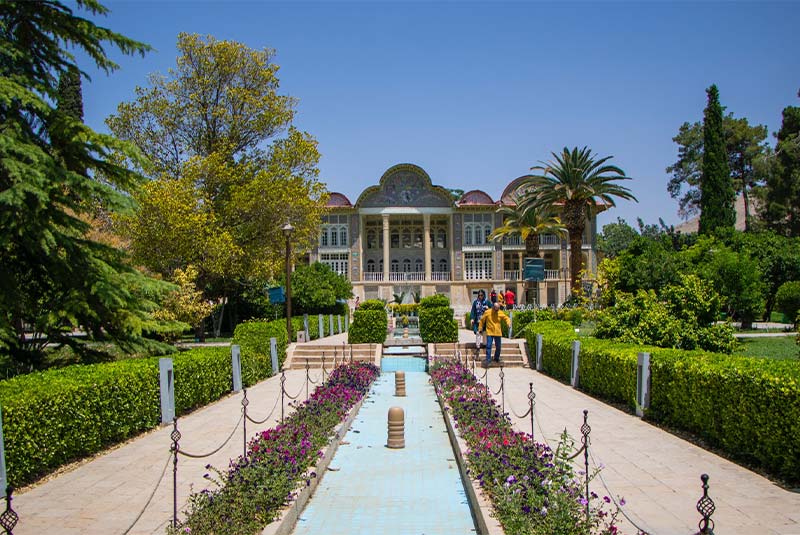
The Eram Garden in Shiraz is located along the northern shore of the dry river (Khoshk River) in Shiraz is another fantastic location for visitors with a variety of plants as well as a historic mansion. Although the exact date of the construction of the garden is not precise, historical evidence suggests that it was constructed during the Seljuk Dynasty (around the 11th-14th centuries) on the orders of the celebrated Seljuk monarch Ahmad Sanjar.
Eram Garden is one of the most famous and beautiful gardens in Iran. The word 'Eram' is derived from the Arabic word 'Iram,' which means heaven in Islam's holiest of books, the Qur'an. It has ponds and fountains that give this beautiful garden the most excellent views, especially at night when the play with lights is functioning. These features, along with the beautiful flowers, refreshing air, beautiful grounds, lush plant life, aesthetic attractions, aromatic myrtles, and towering cypress trees, make it easy to see why Eram evokes such a description.
7. Zandiyeh Complex
One of the most attractive monuments of Shiraz is Zandiyeh Complex. Zandiyeh Complex is in the heart of Shiraz city and goes back to Persian king Karim Khan Zand who ruled southern and central Iran in the 18th century. In Zandiyeh Complex, you will visit Karim Khan Citadel, Pars Museum, Vakil Mosque, Vakil Bazaar, Vakil Bathhouse, and Vakil Water Reservoir, which we will explore. The places are named after the title Vakil because king Karim Khan Zand didn't call himself king; instead, he picked the title "Vakil Al Roaya," meaning the people's deputy.
The Vakil bazaar
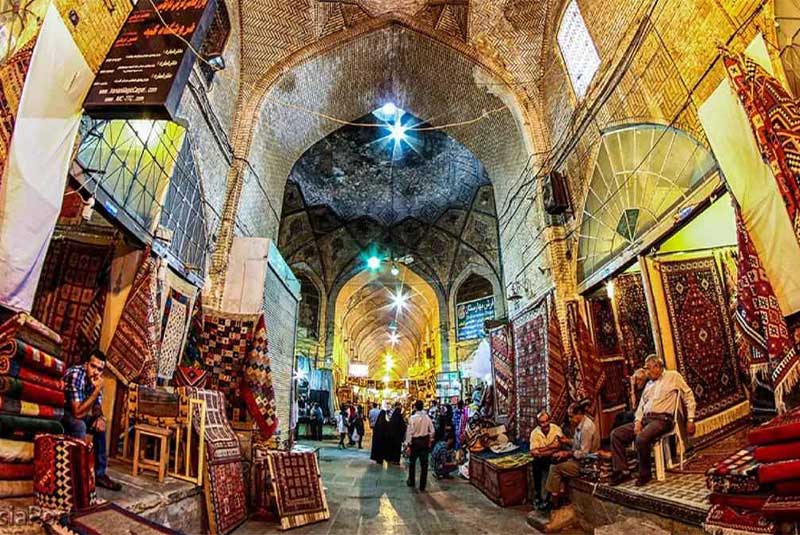
Your visit to Shiraz is incomplete if you don't walk through the alleyways of Vakil Bazaar. The bazaar dates back centuries ago and was the main store center of Shiraz; today, it has become the preferred place for shopping for many things, including copper dishes, local dresses, different kinds of spices, rugs, silver antiques, and so on. It has a peaceful atmosphere where you can spend quite a long time walking in the bazaar, admiring its beauty, and getting some good Iranian souvenirs.
Vakil bath house

Vakil Bathhouse is one of the largest traditional bathhouses in Iran, built by Karim Khan Zand. The bath house is an outstanding example of Zand Dynasty architecture based on standard and highly-developed architecture. Because of its impressive roof, every inch of this building gets marvelous. A multitude of visitors holds their heads up high above the ground when they see the ceiling in this structure.
Vakil Mosque
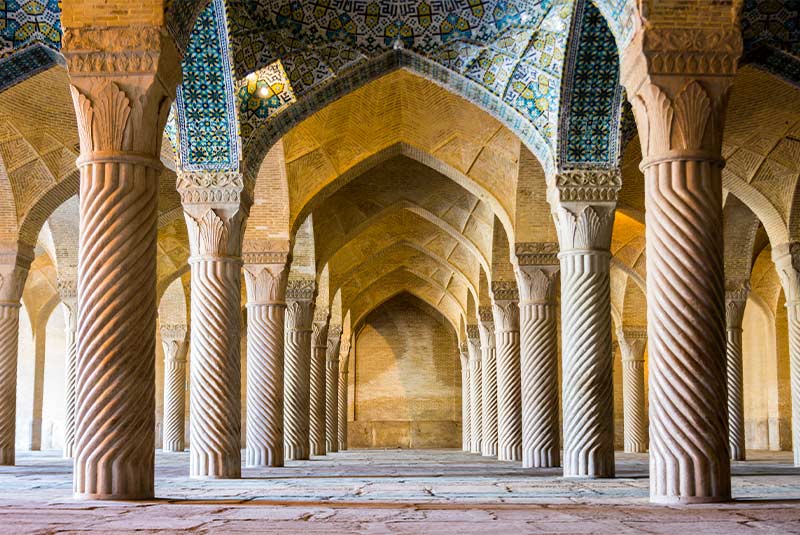
Vakil Mosque is a place of worship with exquisite designs and forms that show the art of Iranians. The rectangular hall and court are decorated with many colors of tiles and different types of Shirazi handicrafts. With the scene of these tiles, you can take beautiful photos there and enjoy your time.
Karim Khan citadel
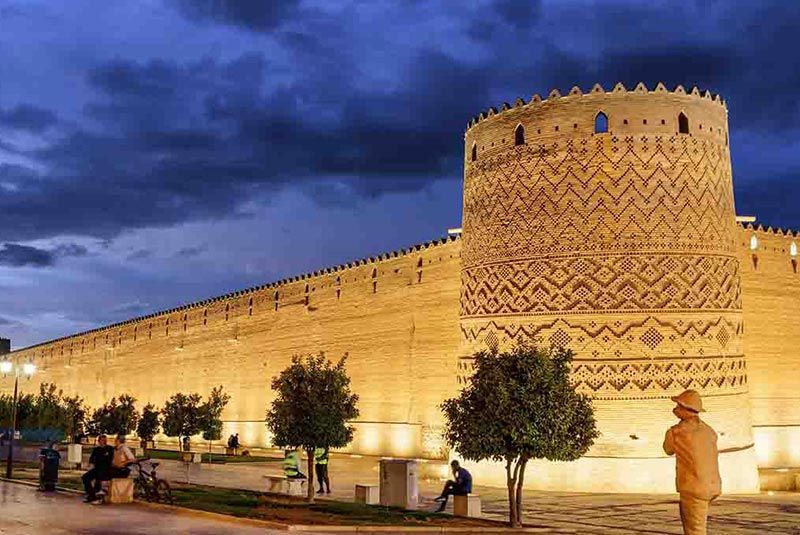
This citadel was the primary residential palace of Karim Khan-e-Zand and his dynasty. It serves as a prominent legacy of the Zand Dynasty in Shiraz, especially from the architectural point of view. This structure was made of stone and stucco, and the best construction materials from all over the country were used during construction. Karim Khan invited the best builders and architects of the time to build this citadel's structures. They made a fortress with beauty and elegance worthy of one of the most just kings of Iran. The Citadel of Karim Khan has four walls of 12-meter height that are attached to 4 circular brick towers of 14-meter height with a 90-degree angle. This citadel is constructed in a way that can have both residential and political functions. It has strong, high external walls with parapets explicitly built for the soldiers and with the purpose of shooting.
8. The Tomb of Hafiz

It is impossible to mention Shiraz's name and not immediately think about Hafiz. Hafiz is like the Shakespeare of Iran; was a gifted and prolific poet and religious scholar whose unique style of poetry was influenced by verses from the Quran and sayings of the prophet Muhammad (peace be upon him). He was considered the seer of love, art, and beauty in Iran.
He is one of the poetry geniuses of all time. He is beloved among Iranians as many people, from children to the elderly, enjoy reading his intelligent, beautiful, and involved poems. Almost every home in Iran contains a copy of his book, which is regularly read and consulted for guidance and inspiration. Hafiz's tomb, commonly known as Hafizieh, is located south of Quran Gate. It is a complex of monuments in a peaceful garden setting that drips with an ambiance of poetry and romance.
Hafez's tomb lies in the Musalla Gardens, inside a small open pavilion, inside which is a marble tombstone with several of the poet's verses. On top of the tomb is a mosaic-tiled dome glowing when lit at night. The current pavilion and surrounding memorial structures were created in 1935 to expand the original memorial built in 1773.
9. The Tomb of Saadi
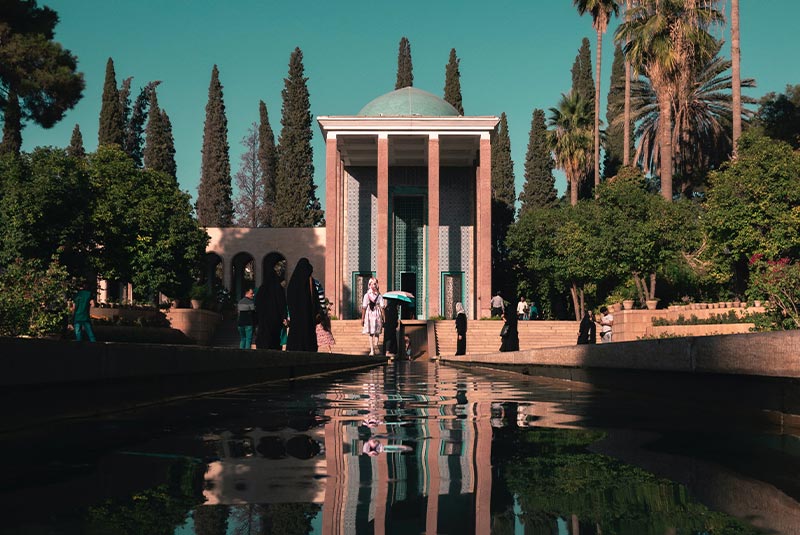
Another famous Iranian poet is Saadi; his poetry has touched many hearts worldwide. He greatly influenced so many people to reach higher levels of humanity. He's widely recognized for his deep social and moral thoughts and is undoubtedly one of the great masters of classical Persian literature.
Saadi's tomb is located northeast of Shiraz and was built between 1950 and 1952. It is set in a pleasant garden with beautiful flowers and several cypress trees, making it a scenery. There is also a fish pond with some water channels into which people throw their coins as a ritual while believing that their wishes will come true.
10. The Qur'an Gate (Darvazeh Quran)
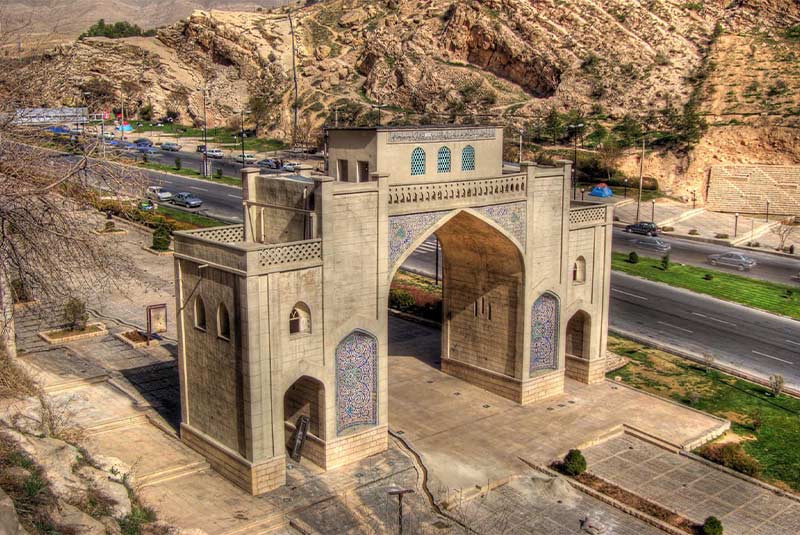
Quran Gate may not seem as crucial as the other tourist attractions of Shiraz; however, visiting the Quran gate is a must as it is one of the prominent symbols of Shiraz. It is one of the oldest gates of Shiraz; this gate is located at one of the entrances of Shiraz, which connects "Isfahan" to "Marvdasht" and "Firuzabad." The gate's name is derived from the Quran (Holy Book) because it contains two hand-written Qur’āns by Sultan Ibrahim Bin Shahrukh Gurekani in a small room above the entrance with dedicated latticework on its windows.
The gate has a great arch that is decorated with some verses from the Quran. The gate structure also has colorful tiling that keeps it stunning and eye-catching. The gate is also decorated with lights, giving it a spectacular visual effect at night. The majestic view of the gate leaves everyone in deep appreciation.
11. Jame Mosque of Atigh
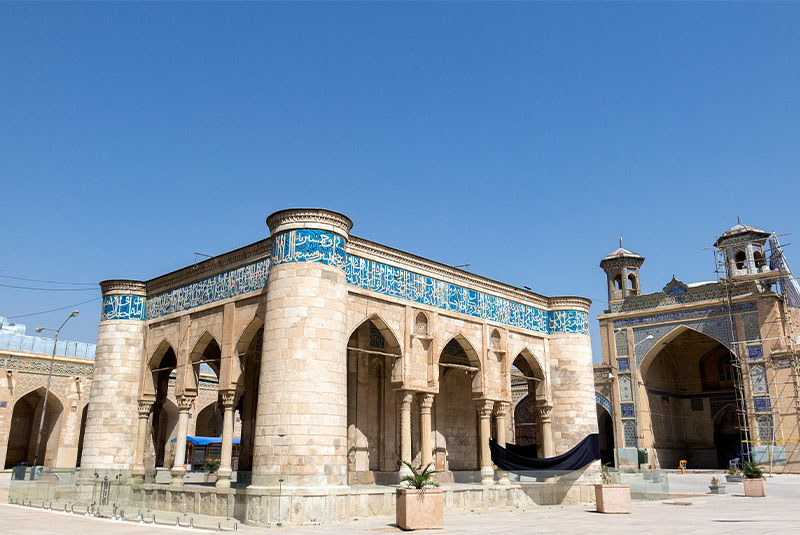
Jame Mosque of Atigh is the oldest and first mosque in Shiraz. It was built in celebration of the conquest of Shiraz by Saffarid Amroleiss in the year 276 AH and was completed in 281 AH. It is located east of Shah Cheragh Shrine and has a wall called "Nodbeh" on the southern part that is different from other walls with a picture of colorful cedar.
The north side of the mosque has an Iwan and Shabestan, an underground space used during summers and could be ventilated by wind catchers and qanats. The height of the building and its various nocturnal areas (Shabestans) with beautiful tile work on the ceilings give a unique charm to this place. Additionally, the dome of the north Iwan and the hypostyle columns are so attractive. The North gate is the Imam Gate, decorated with Mogharnas tiles.
12. Shah Cheragh Monument

Shah Cheragh, meaning "Emperor of Light", is a religious monument in Shiraz with tombs, a mosque, and a museum containing several ancient copies of the Quran. The monument was built during the reign of Atabakan of Fars (in the Sal Ghurid Dynasty) in the 12th century. It contains the tomb of Ahmad and Muhammad, the sons of Imam Musa (A.S), serving as an important pilgrimage location for Shia Muslims.
However, visitors of any faith are likely to marvel at the sheer beauty of this glassy wonder. It has a courtyard and two main entrances with magnificently sprawling tile works on the monument's north and south sides. Around the yard, there are two-story rooms. It has Iron columns covered with exquisite embroidery. Inside the memorial are giant chandeliers hanging like frozen rain, small green lamps jut from the walls, and stained-glass windows shining from high, emitting light that sparkles off countless jewels and shards of glass.
13. Qavam House (Narenjestan Garden)

Narenjestan Garden or Qavam House in Shiraz is undoubtedly one of the most beautiful and praised gardens you will love to visit. Narenjestan Garden was built during the Qajar period in the late 19th century. It got the name Narenjestan (meaning orange garden in Persian) because it has an abundance of sour orange trees. This garden has a canal, a palace in the middle, a terrace, and a rectangular pool and is one of the best examples of Persian art.
This complex has more than 3500 square meters and has two separate parts. The southern part was used by servants and is decorated beautifully with stucco. The northern wing has two stories, and its roof has fantastic mirror works that can keep your head up for hours. Achaemenid soldiers, lions, tombs, and pictures of fighting mythological creatures can be seen on colorful tiles and paintings. Walking through the garden and looking at these patterns will make your day.
14. Bagh-e Jahan Nama (Jahan Nama Garden)
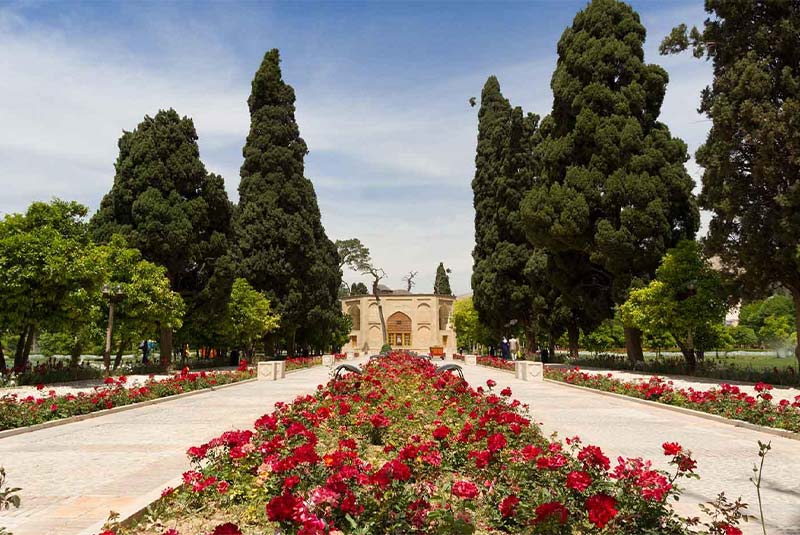
Baghe Jahan Nama is the oldest garden in Mashhad, made in the 13th century during the Qajar era. It is located on Hafez Street and is fed by the Rokni River. This garden has walls and a mansion in the middle surrounded by tall green trees and eye-catching flowers. It has a traditional interior design that increases the beauty and harmony of the garden. The park's ground has massive colorful plants arranged in a geometric design.
15. Sangtarashan cave

Sangtarashan is considered the most extensive artificial cave in the Middle East. It is one of the most beautiful artificial caves in the world; it is located in the Jahrom, Shiraz, in southern Iran, and is over 150 years old. Over 100 stone columns and 12 cave mouths turn the cave into a beautiful hall with corridors, columns, and openings. One can see the whole town from the main entrance to the cave.
16. Maharloo Lake
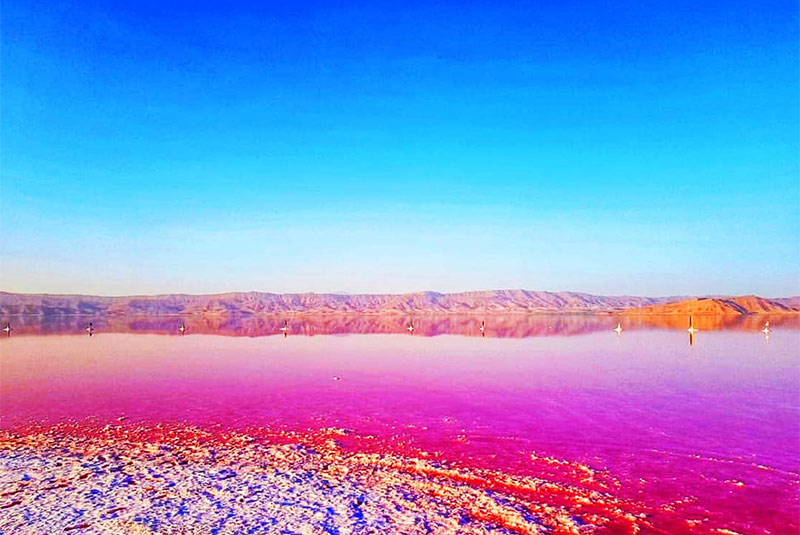
You will enjoy visiting Maharloo Lake (also known as the pink lake) to leave an exciting memory in Shiraz. Maharloo Lake is a seasonal Salt Lake about an hour from Shiraz, with a dominant pink hue. The distinctive color comes from the high amount of red algae at the bottom of the lake. Visitors traveling during mid-summer when rains are less frequent will be able to see the lake in its full glory with its indescribably gorgeous pink tones. It is essential to plan ahead of your visit as during some seasons of the year, the lake is completely gone, leaving behind a salt desert.

